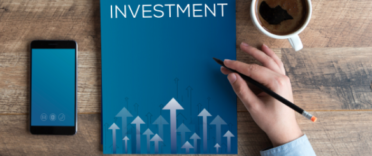
In this article, we explore how much money you'll ideally need to start investing as well as the best ways to invest money when you are starting out. If you're new to investing and are unsure how to start, read our article 'A beginner's guide to investing'.
What is investing?
Investing is when you buy an asset - or a range of assets - in the hope that the value grows over time. Investing can allow you to grow your money further than money held in a savings account. How much money you make on your investments depends on the risk that you choose and typically higher risk investments can see the biggest returns (but also the biggest losses). Investing comes with a level of risk and whilst investments tend to go up over time, they can also go down, so you may lose more than what you put in.
Do you need to be rich to invest?
No. It is often thought that investing is for people with large sums of money but that is no longer the case. A number of investment platforms and mobile apps now let you invest from as little as £1 and while some platforms may ask for a minimum initial investment of £500, they will often accept a monthly commitment from as little as £25 instead.
Investing small regular amounts
Investing a regular amount every month makes investing accessible to all and it is surprising how a small investment can accumulate over time to a sizeable lump sum. It is easy to set up an affordable regular monthly amount and we explain later in this article which platforms allow you to invest from as little as £1. If you are new to investing then starting with a regular investment is probably the best option rather than committing to a larger lump sum that might be eroded through bad timing.
When you start investing you might consider investing small, regular amounts so you can benefit from the advantages of 'pound cost averaging'. To find out more read our article - "The benefits of pound cost averaging and phased investing"
Investing a small lump sum
You may have spent time building your money in a savings account and feel you want to commit some of this to a longer-term investment. You can start investing with a small lump sum and then add to this whenever you have any spare cash. You can also add to this lump sum by setting up a regular monthly investment to accelerate your overall investment. A word of caution, investing a single lump sum could result in your investment suffering from bad timing and a drop in markets could result in an early dip in your investments.
How much money do you need to invest?
If you don't have a lot of money to invest you may be wondering how much you should invest per month in order to build a sizeable pot in the future. In the table below, we share examples of how regularly investing small monthly amounts can help build significant sums over the long term. The examples demonstrate how small monthly amounts can grow, using an assumed 5% annual rate of return over a period of 5 or 10 years. A 5% annual rate of return is the average rate of return for investing in shares over the long term (in excess of inflation) according to the Barclays Equity Gilt Study. The sums shown are after investment fees but remember investments can go down as well as up.
Investing value after 5 and 10 years
| Monthly Amount | Investment value after 5 years* | Investment value after 10 years* |
| £10 | £680 | £1,553 |
| £25 | £1,700 | £3,883 |
| £50 | £3,400 | £7,764 |
| £100 | £6,801 | £15,528 |
| £250 | £17,002 | £38,821 |
*5% annual rate of return over 5 and 10 years minus fees
How long should you invest for?
When planning to invest you should be looking to invest for a minimum period of 5 years to make sure investments have time to recover from the inevitable setbacks involved with investing in stock markets. Investing is a long-term project and the longer you can leave your money to grow the greater the potential for a larger return. Investing for retirement is a popular long-term investment goal.
Things to consider before investing
When you are planning to start investing it is a good idea to consider the following:
- Have you cleared your short term debt? - Short term debt, such as credit cards, will incur a high interest rate and so it would be wise to pay off, or certainly reduce this debt before starting to invest. In our article, we share '4 easy ways to clear your credit card debt'.
- Have you built an emergency fund? - You should plan to have an emergency fund of 3 to 6 months net pay put aside to cover any emergency expenditure so that you do not end up having to cash in your investments and lose money. For more information on how to start building an emergency fund, read our article 'Building an Emergency Fund – the what, why & how'.
- How much do you have to invest? - Aiming too high will only mean you are less likely 'to stick with it' if your finances come under pressure. Start off with a manageable amount and build on it as you move forward.
- Have you set investment goals? - If you have an investment goal, such as retirement, then you are more likely to continue building your investments over the long term. Read our article 'How to set investment goals and timeframes' for tips on setting investment goals.
- What fees are you paying? - If you're only investing small amounts you will need to check the fees with the investing platform you choose. Choosing a provider with high fees could eat into your investment and impact your returns. Compare the best investment platforms to find out the best providers with the lowest investment costs.
Best place to start investing small amounts of money
One of the first things to look for when investing small amounts is whether there are any tax breaks that will help to build your investment quicker.
Stocks & Shares ISA
Investing in an ISA is tax-free which means you will pay no income tax or capital gains tax on your investment. You can invest up to £20,000 a year in an ISA with two types available - cash ISA and stocks and shares ISA.
Investing in a stocks and shares ISA is a good way to dip your toe in the water by investing a small monthly amount that can build up over time with the proceeds being totally tax-free.
To find out more about investing in an ISA read our article - "Where should you invest your ISA allowance?"
Investing platforms with low minimum investments
The following providers have a low minimum investment which is perfect for those with little money. For more information on fund platforms read our article - "Compare the cheapest (and best) investment ISA platforms"
| Investment platform | Minimum investment |
| Wealthify* | £1 |
| AJ Bell* | £1 |
| Interactive Investor* | £25 |
SIPP
A SIPP is a personal pension product where you make the investment choice and get tax relief on your contributions at your marginal rate of tax. If you are a basic rate taxpayer and contribute £100 per month to a SIPP you get an extra £25 put into your pension from the government in the form of tax relief. If you are a higher or additional rate taxpayer then further tax relief can be claimed through your annual tax return. Withdrawals from a SIPP can be made from the age of 55 but are taxed at your marginal rate.
A SIPP is an excellent tax-free product for long-term investment that can be increased over time to provide an income in retirement. To find out more about SIPPs read our article - "What is a SIPP?"
If a link has an * beside it this means that it is an affiliated link. If you go via the link, Money to the Masses may receive a small fee which helps keep Money to the Masses free to use. The following link can be used if you do not wish to help Money to the Masses or take advantage of any exclusive offers - Wealthify, AJ Bell, Hargreaves Lansdown



